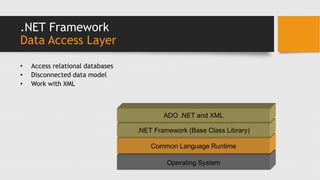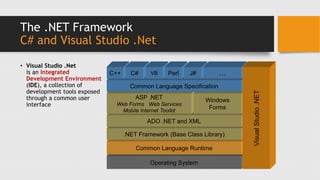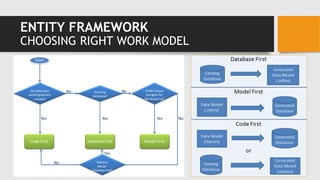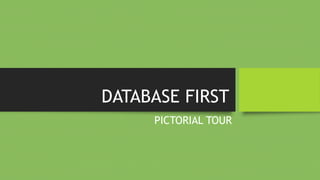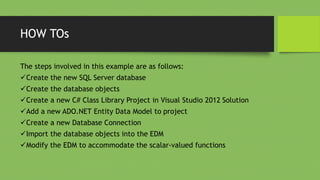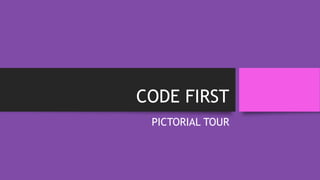Lecture - The .Net Technology and Framework
- 1. THE .NET FRAMEWORK ENTITY FRAMEWORK Mr. Jibran Rasheed Khan
- 2. What is .NET? • .NET is a platform that provides a standardized set of services. • A specific software framework • Includes a common runtime • Programming model for .NET • Platform for running .NET managed code in a virtual machine • Provides a very good environment to develop networked applications and Web Services • Provides programming API and unified language-independent development framework
- 3. The .Net Framework • .Net Framework is software technology developed by Microsoft to create applications for Windows and Web applications. • It includes Framework Class Library (FCL) and provides language interoperability across several programming languages. • Programs execute in a software environment - Common Language Runtime (CLR), an application virtual machine.
- 4. The .Net Framework Architecture • Common Language Specification (CLS) are guidelines, that language should follow for communicating with other .NET languages in a seamless manner. (does mapping) • Common Type System (CTS) is a base class library that contains all type information like Int32, Int64, String , Boolean etc. • Common Language Runtime (CLR) is the execution engine for .NET applications and serves as the interface between .NET applications and the operating system.
- 5. The Core of .Net Framework • Common Language Runtime • Garbage collection • Language integration • Multiple versioning support • Integrated security • Framework Class Library • Provides the core functionality: ASP.NET, Web Services, ADO.NET, Windows Forms, IO, XML, etc
- 6. .NET Framework Common Language Runtime • Manages running code – like a virtual machine • Threading • Memory management • No interpreter: JIT-compiler produces native code – during the program installation or at run time • Fine-grained evidence-based security • Code access security • Code can be verified to guarantee type safety • No unsafe casts, no un-initialized variables and no out- of-bounds array indexing • Role-based security
- 7. .NET Framework Common Language Runtime
- 8. .NET Framework Managed Code • Code that targets the CLR is referred to as managed code • All managed code has the features of the CLR • Object-oriented • Type-safe • Cross-language integration • Cross language exception handling • Multiple version support • Managed code is represented in special Intermediate Language (IL)
- 9. .NET Framework Automatic Memory Management • The CLR manages memory for managed code • All allocations of objects and buffers made from a Managed Heap • Unused objects and buffers are cleaned up automatically through Garbage Collection • Some of the worst bugs in software development are not possible with managed code • Leaked memory or objects • References to freed or non-existent objects • Reading of uninitialized variables • Pointerless environment
- 10. .NET Framework Multiple Language Support • .NET languages are compiled to an Intermediate Language (IL) • IL is also known as MSIL or CIL • CLR compiles IL in just-in-time (JIT) manner – each function is compiled just before execution • The JIT code stays in memory for subsequent calls • Recompilations of assemblies are also possible
- 11. .NET Framework Intermediate Language • IL (MSIL or CIL) – Intermediate Language • It is low-level (machine) language, like Assembler, but is Object-oriented • CTS is a rich type system built into the CLR • Implements various types (int, float, string, …) • And operations on those types • CLS is a set of specifications that all languages and libraries need to follow • This will ensure interoperability between languages
- 12. .NET Framework Common Language Specification (CLS) • All .NET languages have the same primitive data types. An int in C# is the same as an int in VB.NET • When communicating between modules written in any .NET language, the types are guaranteed to be compatible on the binary level • Types can be: • Value types – passed by value, stored in the stack • Reference types – passed by reference, stored in the heap • Strings are a primitive data type now
- 13. .NET Framework Programming Languages • Languages provided by Microsoft • C++, C#, J#, VB.NET, JScript • Third-parties languages • Perl, Python, Pascal, APL, COBOL, Eiffel, Haskell, ML, Oberon, Scheme, Smalltalk… • Advanced multi-language features • Cross-language inheritance and exceptions handling • Object system is built in, not bolted on • No additional rules or API to learn
- 14. .NET Framework Programming Language: C# • Mixture between C++, Java and Delphi • Component-oriented • Properties, Methods, Events • Attributes, XML documentation • All in one place, no header files, IDL, etc. • Can be embedded in ASP+ pages • Everything really is an object • Primitive types aren’t magic • Unified type system == Deep simplicity • Improved extensibility and reusability
- 15. The .NET Framework Common Language Runtime • CLR manages code execution at runtime • Memory management, thread management, etc. Operating System Common Language Runtime
- 16. .NET Framework Base Class Library • Object-oriented collection of reusable types • Collections, I/O, Strings, etc. Operating System Common Language Runtime .NET Framework (Base Class Library)
- 17. .NET Framework Data Access Layer • Access relational databases • Disconnected data model • Work with XML Operating System Common Language Runtime .NET Framework (Base Class Library) ADO .NET and XML
- 18. .NET Framework ASP.NET & Windows Forms • Access relational databases • Disconnected data model • Work with XML Operating System Common Language Runtime .NET Framework (Base Class Library) ADO .NET and XML ASP .NET Web Forms Web Services Mobile Internet Toolkit Windows Forms
- 19. The .NET Framework Common Language Specification • Support wide range of programming languages • Use your favorite language Operating System Common Language Runtime .NET Framework (Base Class Library) ADO .NET and XML ASP .NET Web Forms Web Services Mobile Internet Toolkit Windows Forms C++ C# VB.NET Perl J# …
- 20. The .NET Framework C# and Visual Studio .Net Operating System Common Language Runtime .NET Framework (Base Class Library) ADO .NET and XML ASP .NET Web Forms Web Services Mobile Internet Toolkit Windows Forms Common Language Specification C++ C# VB Perl J# … Visual Studio .NET • Visual Studio .Net is an Integrated Development Environment (IDE), a collection of development tools exposed through a common user interface
- 21. The .NET Framework Standards Compliance Operating System Common Language Runtime .NET Framework (Base Class Library) ADO .NET and XML ASP .NET Web Forms Web Services Mobile Internet Toolkit Windows Forms Common Language Specification C++ C# VB Perl J# … Visual Studio .NET Prog. Language Submitted to ECMA Web services – XML, SOAP-based XML-based data access Open Language Specification
- 22. ENTITY FRAMEWORK
- 23. ENTITY FRAMEWORK WHAT IS? • Entity Framework was released in 2008, Microsoft's primary means of interacting between .NET applications and relational databases • It is a set of ADO.NET technologies that aid in developing data-driven software. • It is an Object Relational Mapping (ORM) framework that allows an automated way to store and access databases. The data access framework to bridge the gap between data structures and objects in the applications. • It is available as part of the .NET development (version 3.5 SP1 and later) • Microsoft’s latest and recommended way for data access for .NET applications. • It allows to develop and maintain data-oriented apps with less code than traditional applications • It eliminates the majority of the data-access code that must routinely write. • It won’t need to know about the underlying database tables and columns where data need to store
- 24. ENTITY FRAMEWORK HIGH LEVEL VIEW
- 25. ENTITY FRAMEWORK VERSION HISTORY ADO.NET Entity Framework Version Supported Framework & IDE Features Detail 6.0 .NET Framework 4.5.1 and Visual Studio 2013 • Async Query and Save • Code-Based Configuration • Dependency Resolution • Interception/SQL logging • Improved Connection Management • Improved Transaction Support 5.0 .NET Framework 4.5 and Visual Studio 2012 • Enum Support in Code First and EF Designer • Spatial Data Types in Code First and EF Designer • Table-Valued Functions • Multiple Diagrams per Model
- 26. ENTITY FRAMEWORK VERSION HISTORY ADO.NET Entity Framework Version Supported Framework & IDE Features Detail 4.3 .NET Framework 4.0 and Visual Studio 2010 Code First Migrations Automatic Migrations 4.2 .NET Framework 4.0 and Visual Studio 2010 The EF 4.2 release included the bug fixes to EF 4.1 4.1 .NET Framework 4.0 and Visual Studio 2010 Code First development Introduced DbContext API Data Annotations and Fluent API Validation
- 27. ENTITY FRAMEWORK VERSION HISTORY ADO.NET Entity Framework Version Supported Framework & IDE Features Detail 4.0 .NET Framework 4.0 and Visual Studio 2010 Model-first development POCO support Lazy Loading T4 Code Generation 3.5 .NET Framework 3.5 SP1 and Visual Studio 2008 SP1 This release provided basic O/RM support using the Database first development
- 28. ENTITY FRAMEWORK ARCHITECTURE • EDM, Consists of Conceptual model, Mapping and Storage model. • LINQ to Entities, Used to write queries against the object model. • Entity SQL, like L2E, but little more difficult. • Object Service, Responsible for materialization. • ECDP, Responsible to convert L2E or Entity SQL queries into a SQL query. • ADO.net, Communicates with the database using standard ADO
- 29. ENTITY FRAMEWORK ENTITY TYPES • POCO Entities (Plain Old CLR Object) POCO entities (also known as persistence-ignorant objects) support most of the same query, insert, update, and delete behaviors as entity types that are generated by the Entity Data Model. A POCO entity is a class that doesn't depend on any framework-specific base class. It is like any other normal .NET CLR class, which is why it is called "Plain Old CLR Objects". • Dynamic Proxy Entities (POCO Proxy) When creating instances of POCO entity types, the Entity Framework often creates instances of a dynamically generated derived type that acts as a proxy for the entity. IT can also be said that it is a runtime proxy classes like a wrapper class of POCO entity. Dynamic Proxy is a runtime proxy class which wraps POCO entity. Dynamic proxy entities allow lazy loading.
- 30. ENTITY FRAMEWORK LAZY LOADING Lazy Loading is the strategy to identify resources as non- blocking (non-critical) and load them only when needed. It is the default behavior of Entity Framework, which means that the related entities or child entities are loaded only when it is being accessed for the first time. That means in simple words we can say that Lazy loading simply delays the loading of related entities until you specifically request it.
- 31. ENTITY FRAMEWORK ENTITY PROPERTY Entities mainly consist of two types 1. Scalar Property Scalar properties are those properties that are primitive. It maps a column in a database table that stores the data. E.g., student id, student name, class are the scalar property of a student entity. 2. Navigation Property This property is responsible for the relationship of one entity to another. There are two types of navigation properties: i) Reference Navigation Property When an entity has the property of another type of entity property, it is called reference navigation property. It points to a single entity but represents the multiplicity of one. ii) Collective Navigation Property When an entity has the property of generic collection type, it is known as collective navigation property. It has the multiplicity of many.
- 32. ENTITY FRAMEWORK ENTITY STATES • The entity framework API maintains the state of each entity during its lifetime. Each entity has a state based on the operation performed on it via the context class. The entity state represented by an enum System.Data.Entity.EntityState. • The entity framework API builds and executes the INSERT, UPDATE, and DELETE commands based on the state of an entity when the context.SaveChanges() method is called. • The Context class not only holds the reference to all the entity objects as soon as retrieved from the database, also keeps track of entity states. • The change in entity state from the Unchanged to the Modified state is the only state that's automatically handled by the context. • All other changes made explicitly by using methods of DbContext or DbSet. • Entity States • Added • Modified • Deleted • Unchanged • Detached
- 34. ENTITY FRAMEWORK APPROACHES DATABASE FIRST Model the database artifacts (tables, views, primary keys, foreign keys, etc.) Allows you to use legacy database in your ORM application Low level control over the database Entity Data Model can be updated whenever database schema changes. Database-first approach supports stored procedure, view, etc. MODEL FIRST Creating a model using the Entity Framework designer tools Designer can generate DDL statements to create the database An easy-to-use UI allows quickly create new entities Separation of code and database in a declarative format Dropping and re-creating the database is not a choice This uses an .EDMX file to store model and mapping information. CODE FIRST The primary focus is getting the code and logic Define entity model with classes and mappings in code.. Entity Framework create (and recreate) the database for you. Does not use Entity Framework visual design tool, neither to design entities There is no XML file – no EDMX file – to represent model and storage schemas
- 35. ENTITY FRAMEWORK CHOOSING RIGHT WORK MODEL
- 37. ENTITY FRAMEWORK FEATURES • Multiple DB Support Works with a variety both relational and non-relational servers including Microsoft SQL, MySql, Oracle, and DB2. • Cross-platform a cross-platform framework which can run on Windows, Linux and Mac • Modelling creates an EDM based on POCO (Plain Old CLR Object) entities with get/set properties of different data types. • Querying use LINQ and SQL queries to retrieve data from the underlying relational database. • Change Tracking keeps track of changes occurred to instances of entities (Property values) • Saving executes INSERT, UPDATE, and DELETE commands when call the SaveChanges() and SaveChangesAsync() method • Concurrency Optimistic Concurrency by default to protect overwriting changes made by another user • Transactions performs automatic transaction management while querying or saving data. • Caching repeated querying will return data from the cache instead of hitting the database. • Built-in Conventions follows conventions over the configuration which automatically configure the EF model. • Configurations allows us to configure the EF model by using data annotation attributes or Fluent API • Migrations commands can be executed on the NuGet Package Manager Console or CLI to create or manage underlying database Schema.
- 38. ENTITY FRAMEWORK ADVANTAGES • Reduced development time • Developers can work more application-centric • Free from hard-coded dependencies on a particular data engine • Mappings can be change without changing the application code • L2Eprovides validation for writing queries against a conceptual model • Integrates with all the .NET application programming models • Worked well with ASP.NET, WPF, WCF, and WCF Data Services
- 40. HOW TOs The steps involved in this example are as follows: Create the new SQL Server database Create the database objects Create a new C# Class Library Project in Visual Studio 2012 Solution Add a new ADO.NET Entity Data Model to project Create a new Database Connection Import the database objects into the EDM Modify the EDM to accommodate the scalar-valued functions
- 41. 01 02 03
- 42. 04 05 06
- 43. 07 08 09
- 44. 12 11 10
- 45. Features
- 46. Advantages
- 48. HOW TOs The steps involved in this example are as follows: Creating the model Creating entities in the .edmx Editing entity properties Applying relationships to the entities Name DatabaseSchema Generating the database from the model
- 49. 01 03 02
- 50. 06 05 04
- 51. 09 08 07
- 52. 10 11 12
- 53. 15 14 13
- 54. 16 17 18 19 20 21
- 55. Features
- 56. Advantages
- 58. HOW TOs The steps involved in this example are as follows: Create a new Class Library Create POCO (Plain Old CLR Object) classes Add data annotations to the POCO classes. Create enum classes (if required) Add Entity Framework to the Solution Add a DbContext class Add ‘Code First Migrations’ Updates the database (if needed/made changes)
- 59. 01 02 03 04
- 60. 04 05 06
- 61. 07
- 62. FEATURES
- 63. ADVANTATES
- 64. Question & Answer “A wise man can learn more from a foolish question than a fool can learn from a wise answer.” Bruce Lee
- 65. THANK YOU Have Great Time

















